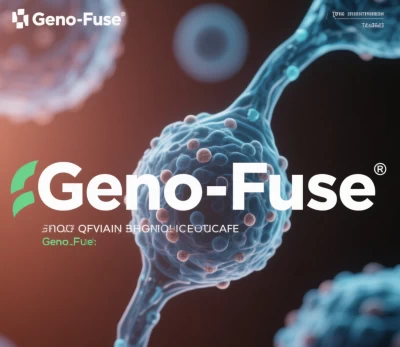
GenoFuse is a specialized bioinformatics tool designed to detect and visualize target gene fusion events from DNA sequencing data, with critical applications in cancer genomics. By integrating high-throughput sequencing (NGS) and algorithmic optimization, it addresses challenges in identifying gene fusions from low tumor purity samples (e.g., circulating tumor DNA). Below is a detailed analysis of its definition, technical principles, applications, and industry impact:
1. Core Definition and Technical Focus
GenoFuse specializes in identifying clinically significant gene fusions, typically caused by chromosomal structural variations (e.g., translocations, inversions) that drive cancer progression or influence therapeutic responses. Key features include:
- High Sensitivity and Specificity: Reliable detection even in low tumor DNA content (e.g., ctDNA), achieving 100% specificity.
- Clinical Database Integration: Leverages COSMIC (Catalogue of Somatic Mutations in Cancer) to report only clinically or oncologically relevant fusions.
- Open Source and Visualization: Open-source code (available on GitHub) with interactive HTML reports displaying fusion breakpoints, supporting sequences, and protein structure predictions.
2. Technical Workflow
GenoFuse operates through four stages:
- Index Construction: Generates k-mer indexes for reference genomes to accelerate sequence alignment.
- Sequence Matching: Aligns raw sequencing reads to genomic coordinates to identify potential fusion breakpoints.
- Filter Optimization: Filters false positives based on database priority and sequencing quality.
- Result Reporting: Generates text and interactive HTML reports for cloud-based validation.
3. Comparison with Competing Tools
| Feature | GenoFuse | FACTERA / DELLY |
|---|---|---|
| Detection Target | Clinically curated fusions (COSMIC) | Genome-wide structural variations |
| Data Input | Raw FASTQ files (no pre-alignment) | Requires BAM files |
| Speed | High efficiency (optimized indexing) | Slower (whole-genome scanning) |
| Use Case | Clinical diagnostics, liquid biopsy | Research, novel fusion discovery |
4. Applications
- Precision Cancer Therapy:
- Detects ALK and ROS1 driver gene fusions in non-small cell lung cancer (NSCLC), guiding targeted therapies (e.g., crizotinib).
- Enables non-invasive monitoring of resistance mutations (e.g., EGFR T790M) in circulating DNA.
- Companion Diagnostics:
- Compatible with Illumina sequencing platforms for integration into commercial NGS panels.
5. Strengths and Limitations
- Strengths:
- Low Sample Requirements: Ideal for minimally invasive biopsies or liquid biopsies.
- Clinical Relevance: Filters non-actionable fusions, enhancing diagnostic efficiency.
- Limitations:
- Database Dependency: Cannot identify novel fusions without external tools.
- Computational Demand: Requires high-performance clusters for large-scale exome analysis.
6. Industry Impact and Future Directions
GenoFuse exemplifies the evolution of clinical-grade fusion detection tools, emphasizing:
- Clinical Utility: Reduces data overload by focusing on pre-defined targets.
- Automation and Interpretability: User-friendly HTML reports facilitate pathologist validation.
Future advancements may include:
- Multi-Omics Integration: Validating fusions with RNA-seq data.
- AI Enhancement: Applying deep learning models (e.g., Transformers) to predict functional impacts of fusion proteins.
Conclusion
GenoFuse is a pivotal tool in cancer genomics, addressing critical challenges in gene fusion detection through optimized algorithms and clinical database integration. While limited to known fusions, its high sensitivity, open-source nature, and intuitive reporting make it indispensable for companion diagnostics and translational research. As liquid biopsy adoption grows, GenoFuse is poised to become a standard in tumor molecular profiling.
Content generated by AI. For inquiries, please contact: chuanchuan810@gmail.com





Geno Fuse 目前没有统一的标准化定义,但根据术语构成(”Geno-“基因相关 + “Fuse”融合/整合)和生物技术领域的发展趋势,可能指向以下几种技术方向或应用场景:
一、基因数据融合技术
多组学数据整合分析
将基因组(Genomics)、转录组、蛋白质组等不同层级的生物数据通过算法(如AI模型)进行融合分析,用于疾病机制研究或精准医疗。
例如:整合患者的基因突变和蛋白质表达数据,预测药物响应。
基因-环境交互建模
融合基因序列与环境因素(如饮食、微生物组)数据,构建复杂性状预测模型。
二、基因编辑工具优化
CRISPR技术增强
通过融合不同核酸酶或功能域(如Base Editor与Prime Editor特性结合),开发新型基因编辑工具。
例如:将高精度编辑与长片段插入能力”融合”到单一系统中。
合成生物学元件组装
自动化平台(如AI辅助设计)将多个基因模块(如启动子、报告基因)快速拼接成功能回路5。
三、商业产品/项目名称
可能是某公司/研究机构的专有技术命名,类似”GeneFuse”(某基因融合检测软件)或”FuseGen”(合成生物学初创企业)6。
需结合具体场景判断,如:
基因治疗载体开发平台
多模态生物数据库接口